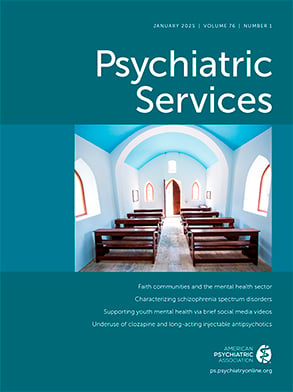Community-based and state-funded mental health services continue to diminish along with availability of psychiatric inpatient beds in many parts of the country. In turn, psychiatric emergency services face assessment and management of higher volumes of patients whose illnesses generally are more acute than seen previously. To help psychiatric emergency staff prepare for this crisis, trainees and senior faculty across the country have collaborated to write a clinically focused, up-to-date resource “that can be read by trainees in many different disciplines.” Drawing from expert insight and practical first-hand experience of trainees, the book positions itself uniquely amidst several other positively reviewed books on the same topic (
1–
3). Admittedly, this manual is “not meant to be a textbook” but a handy guide to enable readers to “review the key points, as needed, just before seeing a patient.” As reviewed below, the manual has largely met its goal, despite occasional lengthy passages bearing resemblance to a textbook and redundantly presented information.
Chapter 1 covers the basics of approaching a patient, interviewing, managing agitation, and completing documentation, as well as several special circumstances (including telephone emergencies, abuse, legal custody, and communication barriers). As the authors write, “One of the clinician's most important jobs is to provide clear and thorough documentation.” Work in psychiatric emergency services is often fast paced with potentially complex cases and the need to resolve conflicting information, which can make documentation arduous. Additional useful tips on documentation are available in “Legal and Ethical Issues” (chapter 12). Complete yet efficient documentation in this harried setting continues to be challenging, especially given the ever-increasing awareness of medicolegal implications; hence, guidance on developing this essential skill is welcomed.
Chapters 2 through 9 are clinically focused and run the gamut, covering patients who are suicidal, violent, catatonic, affectively disordered, psychotic, anxious, cognitively impaired, and using substances. Although chapters focusing on clinical symptoms are designed to be read independently in a short amount of time, they often contain large amounts of background information and details as part of an extensive workup. With this level of detail, a reader may not be able to quickly harness the essential clinical questions and findings needed to make an appropriate triage decision. Inclusion of concise decision trees might have been helpful.
Chapters 10 through 14 cover special topics: child and adolescent patients, seclusion and restraint, legal and ethical issues, disposition and resource options, and transfer of patients from the clinic into psychiatric emergency services. Finally, chapters 15 and 16 stand out as valuable components because of their emphasis on training and education, providing a worthwhile read for clinical supervisors, residents, and medical students. Dr. Hung and Dr. Azzam demonstrate skill in articulating models for supervision of trainees in the psychiatric emergency service, which could be applied to various clinical settings in psychiatry and other medical specialties.
Readers will find three similar tables on the use of medications for agitation located in different chapters. Unfortunately, this results in some redundancy. Choosing the appropriate psychotropic medication, when indicated, is an essential yet difficult skill to master. It would have been useful to have a separate pharmacology section, with sufficient details and relevance to the psychiatric emergency setting as an alternative to these medication tables, which present similar information but with subtle differences and varying completeness. Additional critiques could be made about the need for more information on dealing with difficult patients, parasuicidal gestures, malingering, and factitious disorders because such cases often consume an extensive amount of staff time and resources.
This book is highly recommended reading for trainees. Of note, editing was done with care to ensure that chapters read well together and avoid contradictions. Suitable for any emergency room, the Clinical Manual of Emergency Psychiatry is clinically focused and practical enough to be useful for residents, medical students, and clinical social workers interested in building competency in handling psychiatric emergencies.
The reviewers report no competing interests.

